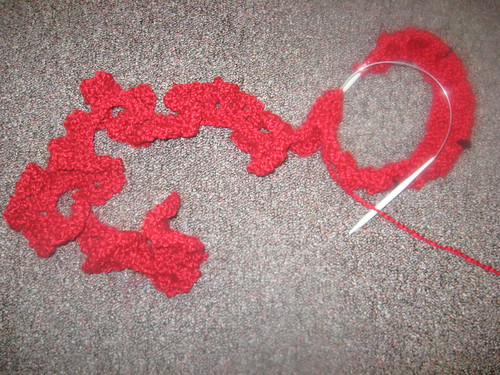Sock Madness III design
***********************************
Tessellation

I love colorwork, and this slipstitch pattern is one of the easiest ways to do it. The original stitch pattern came from a tea cozy pattern, but I used it to make a sweater for my daughter, converting it to circular for the sleeves. I thought it might make a cozy and colorful sock. Hope you think so, too!
Materials:
- fingering weight: 70g main color (MC); 15-20g each of two contrasting colors (A and B) –OR- 70g MC and 30-40g painted or highly variegated; I used Elann’s Peruvian Baby Silk, in Sapphire (MC), Parchment (color A), and Cornflower (color B)
- set of 5 dp needles, size 2, or size to get gauge
- stitch markers (optional)
- yarn needle
Gauge:
9 stitches/inch in stockinette
Terms:
- dip stitch(dpst): Insert needle into stitch three rows below next stitch; pull through a loop of working yarn and place it on left needle. Knit this loop together with the next stitch, through the back loops.
- wrap next stitch (purling): bring yarn to back, slip next stitch from left needle to right, bring yarn to front, slip stitch back to left needle
- wrap next stitch (knitting): bring yarn to front, slip next stitch from left needle to right, bring yarn to back, slip stitch back to left needle
- w&t: wrap and turn
- kfb: knit in front and back
- m1: make one by lifting bar between the last stitch knitted and the next stitch using the left needle and going from the front; knit this stitch through the back loop
Notes:
Just a few hints that may help:
-When doing the short-rowed heel, you can place a stitch marker each time you slip the wrapped stitch back to the left needle; this makes it easier to see where the next wrap should go. This uses a blurt-load of stitch markers, but it’s a lifesaver, if you have to put your work down in the middle of the heel! When working the wrapped stitches, take the stitch markers out only after the stitch and its wraps have been knit; slip the marker and the stitch when you do the second wrap, then slip both back.
-A very useful way to hide the wraps on short rows is shown in two Cat Bordhi YouTube videos:
Part 1: http://www.youtube.com/watch?v=_yVikAvPuE4
Part 2: http://www.youtube.com/watch?v=kFrVqx-iN7k
-To avoid having a bazillion ends to weave in, you can just carry the colors not in use up the side of the sock at the beginning of the round, running the working yarn behind the others on one round, then in front on the next, and twisting them all together when changing colors.
Toe:
Using a figure 8 cast on, (http://www.knitty.com/issuewinter02/FEATtiptoptoes.html), a Magic cast on (http://www.knitty.com/ISSUEspring06/FEATmagiccaston.html), or your preferred method, cast on 16 stitches. Knit one round, making sure to k tbl on the twisted stitches, if you used the figure 8 cast on.
Round 2: (kfb of first stitch, k6, kfb in next stitch) twice
Round 3: (kfb, k8, kfb) twice
Round 4: (kfb, p10, kfb) twice
Round 5: k
Repeat rounds 4 and 5, increasing the number of stitches between the kfbs by two each increase round (so round 6 would have k12 between them) until there are a total of 64 stitches, 32 for the instep, 32 for the sole. On the following round, k16, m1, k 32, m1, k to the end of the round. There are now 66 sts., with 33 on the instep and 33 for the sole. Knit 3 rounds with no increases.
Begin pattern:
Round 1: with A, (sl 3, k1, dpst, k1) 5 times, sl 3; k1, (sl 1, k1) to the end of the round
Round 2: with A, k1, (sl 1, k5) 5 times, sl 1, k1; k1, (sl 1, k1) to the end of the round
Round 3: with MC, (k3, sl 3) 5 times, k3; sl 1 (k1, sl 1) to the end of the round
Round 4: with MC, k4, (sl 1, k5) 4 times, sl 1, k4; sl 1 (k1, sl 1) to the end of the round Round 5: with MC, k4, (sl 1, k5) 4 times, sl 1, k4; k to the end of the round
Round 6: with MC, k
Round 7: with B, (k1, dpst, k1, sl 3) 5 times, k1, dpst, k1; sl 1, (k1, sl 1) to the end of the round
Round 8: with B, k4, (sl 1, k5) 4 times, sl 1, k4; sl 1, (k1, sl 1) to the end of the round
Round 9: with MC, (sl 3, k3) 5 times, sl 3; k1, (sl 1, k1) to the end of the round
Round 10: with MC, k1, (sl 1, k5) 5 times, sl 1, k1; k1, (sl 1, k1) to the end of the round
Round 11: with MC, k1, (sl 1, k5) 5 times, sl 1, k1; k to the end of the round
Round 12: with MC, k
Repeat these 12 rows until foot measures 2” less than final desired length, ending with row 4, 5, 10 or 11.
Begin short-row heel: (done with MC)
(worked back and forth over half the stitches)
Round 1: Work in pattern for 33sts (note the round number); k 32, w&t
Row 2: p31, w&t
Row 3: k30, w&t
Repeat rows 2 and 3, decreasing the number of stitches worked before the wrap by 1 on each row until there are 9 stitches left unwrapped, ending with a wrong side row.
Row 4: k9, knit next stitch along with its wrap, wrap next stitch (there are now two wraps on this stitch), turn
Row 5: p10, purl next stitch along with its wrap, w&t
Row 6: k11, knit next stitch with both its wraps, w&t
Row 7: p12, purl next stitch with both its wraps, w&t
Repeat rows 6 and 7, increasing the number of stitches worked before the wrap by 1 on each row, until all heel stitches and wraps have been worked, ending with a wrong side row and turning, then knitting across the heel to the start of the round.
You still have 66 sts.
Leg:
Begin leg pattern on the round following the round you noted when you started the heel.
Round 1: with A, (sl 3, k1, dpst, k1) 11 times
Round 2: with A, k1, (sl 1, k5) 10 times, sl 1, k4
Round 3: with MC, (k3, sl 3) 11 times
Round 4: with MC, k4, (sl 1, k5) 10 times, sl 1, k1
Round 5: with MC, k4, (sl 1, k5) 10 times, sl 1, k1
Round 6: with MC, k
Round 7: with B, (k1, dpst, k1, sl 3) 11 times
Round 8: with B, k4, (sl 1, k5) 10 times, sl 1, k1
Round 9: with MC, (sl 3, k3) 11 times
Round 10: with MC, k1, (sl 1, k5) 10 times, sl 1, k4
Round 11: with MC, k1, (sl 1, k5) 10 times, sl 1, k4
Round 12: with MC, k
Repeat these 12 rows 5 more times, for a total of 6 runs through the pattern on the leg. Tie off colors A and B as you finish with them on the last run-through of the pattern.
Cuff:
With MC, (Ktbl, p) to the end of the round. Continue until ribbing measures 1”. Bind off loosely.
Finishing:
Weave in loose ends.
















